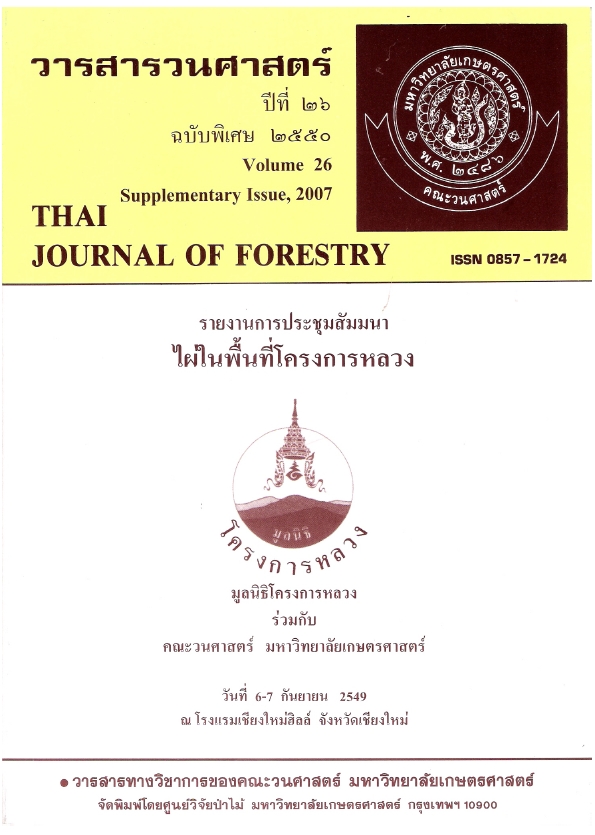Leaf, Spathe, Sprout Coat, and Branch Utilization of Dendrocalamus latiflorus and Bambusa oldhamii
Main Article Content
Abstract
The experiment was aimed to utilize the Dendrocalamus latiflorus and Bambusa oldhamii leaves, spathe, sprout coat and branch. Results indicated that D. latiflorus leaf ranking 5-8 from the tip could be used for packaging Bajang. The average of leaf width, length, wet weight and dry weight were 9.43 cm, 38.78 cm, 3.69 g and 1.57 g, respectively. The color fixation with 1% sodium bicarbonate for 5 minutes and 100 ppm clorine for 30 minutes after drying at room temperature, color appearance (L* a* b*) 63.83, 14.07 and 11.65, 8.97% moisture, Aw 0.496, total plate count. Yeast and mold were less than 10 colony/g, coliform and bacteria were not found in product. The consumer acceptable test indicated that the product met with general acceptance at a rather high level. The results from leaf pulp production showed the optimum cooking condition with 25% sodium hydroxide of total dry basis at 100 'C for 3 hours which would have pulp yield of 30.48% for D. latiflorus and 11.32% for B. oldhamii. The optimum cooking condition of spathe used 30% sodium hydroxide of total dry basis at 100 °C was 6 hours, which would have pulp yield of 39.50%. The optimum cooking condition of sprout coat used 35% sodium hydroxide of dry material at 100 °C was 6 hours, which would have pulp yield of 35.70%. The optimum cooking condition of branch used 40% sodium hydroxide of total dry basis at 100 °C was 10 hours which would have pulp yield of 36.23% for D. latiflorus and 34.73% B. oldhamii. The optimum bleaching condition of spathe used 8% hydrogen peroxide with 2% sodium silicate and 0.05% magnesium sulphate as well as 1.5% sodium hydroxide of dry pulp at 100 °C for 2 hours the brightness was 59.06%. The optimum bleaching condition of branch used 25% hydrogen peroxide with 2% sodium silicate and 0.05% magnesium sulphate as well as 1.5% sodium hydroxide of dry pulp at 100 °C for 2 hours the brightness was 54.29%. Mechanical properties of paper made from bamboo leaves were as follows: basis weight 125 5g/m2, folding endurance 9.22 time, tensile index 7.49 N.m/g, smooth index 1.32 sec, tear index 14.61 mN.m2/g, burst index 1.596 kPa.m2/g and brightness 40.08%. Mechanical properties of unbleaching paper made from bamboo spathe were as follows: basis weight 125 5 g'm2, folding endurance 17.11 time, tensile index 9.33 N.m/g, smooth index 0.95 sec, tear index 16.53 mN.m2/g, burst index 1.864 kPa.m2/g and brightness 47.46%. Mechanical properties of bleaching spathe paper were as follows: basis weight 125 5 g/m2, folding endurance 24.77 time, tensile index 9.49 N.m2/g, smooth index 1.13 sec, tear index 19.57 mN.m2/g, burst index 1.973 kPa.m2/g and brightness 68.37%. Mechanical properties of paper made from branch were as follows: basis weight 125 5 g/m2, folding endurance 1.33 time, tensile index 6.19 N.m/g, smooth index 1.95 sec, tear index 15.63 mN.m2/g, burst index 1.632 kPa.m2/g and brightness 70.07%. In conclusions, this experiment was found that D. latiflorus leaves could be used for Bajang packaging. Handmade paper produced from D. latiflorus and Bambusa oldhamii leaves, sprout and branch could be used as raw material for handicraft and packaging.
Keywords: Non-woody-bamboo utilization, Dendrocalamus latiflorus, Bambusa oldhamii, Royal Project Foundation
Downloads
Article Details

This work is licensed under a Creative Commons Attribution-NonCommercial-NoDerivatives 4.0 International License.
ข้าพเจ้าและผู้เขียนร่วม (ถ้ามี) ขอรับรองว่า ต้นฉบับที่เสนอมานี้ยังไม่เคยได้รับการตีพิมพ์และไม่ได้อยู่ในระหว่างกระบวนการพิจารณาตีพิมพ์ลงในวารสารหรือสิ่งตีพิมพ์อื่นใด ข้าพเจ้าและผู้เขียนร่วม (ถ้ามี) ยอมรับหลักเกณฑ์และเงื่อนไขการพิจารณาต้นฉบับ ทั้งยินยอมให้กองบรรณาธิการมีสิทธิ์พิจารณาและตรวจแก้ต้นฉบับได้ตามที่เห็นสมควร พร้อมนี้ขอมอบลิขสิทธิ์ผลงานที่ได้รับการตีพิมพ์ให้แก่วารสารวนศาสตร์ คณะวนศาสตร์ มหาวิทยาลัยเกษตรศาสตร์ กรณีมีการฟ้องร้องเรื่องการละเมิดลิขสิทธิ์เกี่ยวกับภาพ กราฟ ข้อความส่วนใดส่วนหนึ่ง หรือ ข้อคิดเห็นที่ปรากฏในผลงาน ให้เป็นความรับผิดชอบของข้าพเจ้าและผู้เขียนร่วม (ถ้ามี) แต่เพียงฝ่ายเดียว และหากข้าพเจ้าและผู้เขียนร่วม (ถ้ามี) ประสงค์ถอนบทความในระหว่างกระบวนการพิจารณาของทางวารสาร ข้าพเจ้าและผู้เขียนร่วม (ถ้ามี) ยินดีรับผิดชอบค่าใช้จ่ายทั้งหมดที่เกิดขึ้นในกระบวนการพิจารณาบทความนั้น”


